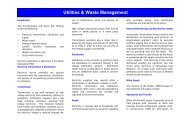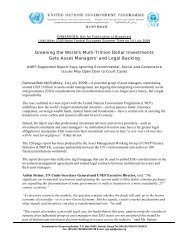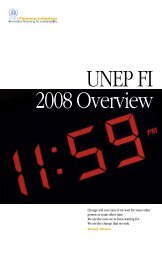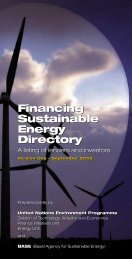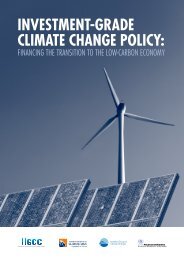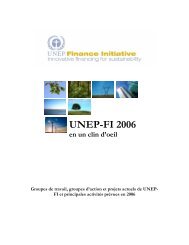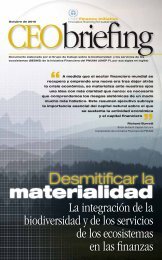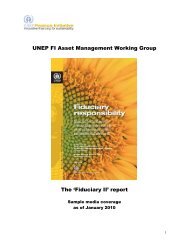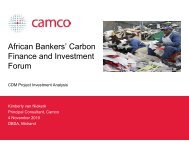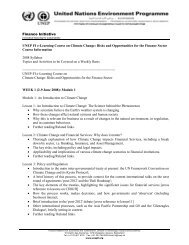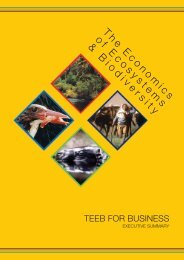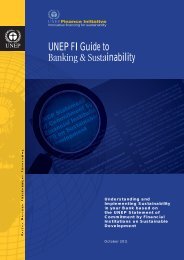Carbon 2009 Emission trading coming home - UNEP Finance Initiative
Carbon 2009 Emission trading coming home - UNEP Finance Initiative
Carbon 2009 Emission trading coming home - UNEP Finance Initiative
You also want an ePaper? Increase the reach of your titles
YUMPU automatically turns print PDFs into web optimized ePapers that Google loves.
<strong>Carbon</strong> <strong>2009</strong><br />
enhancement of forest carbon<br />
stocks in developing countries.<br />
The aim of such an approach<br />
is to address the concern of<br />
permanence of deforestation and<br />
degradation, or in other words to<br />
ensure that the forest that has<br />
been saved is not cut down later<br />
on.<br />
According to 60 percent of those<br />
that think the parties will reach<br />
an agreement in Copenhagen,<br />
deforestation/REDD will be a<br />
key element of the up<strong>coming</strong><br />
framework (see Figure 4.3).<br />
This share is the highest among<br />
respondents in Brazil (75 percent)<br />
and in the US (72 percent). This<br />
reflects the high share of forests<br />
in Brazil, and their obvious interest<br />
in having an agreement that<br />
includes some kind of mechanism<br />
from reducing emissions from<br />
deforestation; and for the US, its<br />
historically strong emphasis on<br />
forests. In the EU, that share is<br />
only 54 percent. This could reflect<br />
its existing skepticism, which<br />
so far has materialised in the<br />
ineligibility of CERs from forestry<br />
for compliance in EU ETS.<br />
REDD a key element<br />
for US and<br />
Brazil respondents<br />
How will deforestation/REDD<br />
be included in the up<strong>coming</strong><br />
framework? The options are not<br />
crystal-clear, which reflects in the<br />
almost 10 percent of respondents<br />
who say they do not know or<br />
have no opinion, as shown in<br />
Figure 4.4. The outcome will<br />
most likely be different from the<br />
options given in this survey, as<br />
this could be a bargaining chip<br />
in the negotiations, and because<br />
the issue is complex.<br />
Figure 4.4: How will REDD fit?<br />
Respondents who expect REDD as a key element post-2012. N=1036.<br />
REDD will produce tradable credits in a separate<br />
mechanism. However, there will be<br />
restrictions/limitations on the use of REDD<br />
credits by developed (Annex 1) countries.<br />
REDD will become part of the Clean<br />
Development Mechanism (CDM)<br />
REDD will produce tradable credits in a separate<br />
mechanism. It will be integrated with the global<br />
carbon market in a similar way to the CDM.<br />
REDD will not produce tradable credits. It will<br />
receive funding from outside the carbon market.<br />
Share of respondents<br />
Source: Point <strong>Carbon</strong><br />
Other, please specify:<br />
Don't know/no opinion<br />
In total, among those that believe<br />
deforestation/REDD will be a<br />
key element in the post-2012<br />
framework, most respondents<br />
(54 percent) believe these<br />
reductions will create tradable<br />
credits in a separate mechanism;<br />
30 percent believing their use by<br />
Annex I countries will be limited,<br />
24 percent thinking it will be part<br />
of the global market in a similar<br />
way to the CDM.<br />
On the other hand, 26.5 percent<br />
think these emission reductions<br />
will be part of the CDM, whereas<br />
only 9 percent of respondents<br />
believe this kind of emission<br />
reductions will not create credits<br />
in the carbon market, but get<br />
funding outside. So far, the<br />
UNFCCC has only registered one<br />
forestry project, and CERs from<br />
forestry will not be allowed for<br />
compliance in EU ETS in phase 3<br />
(starting in 2013) either.<br />
In Brazil, the country with the<br />
highest potential for REDD, the<br />
modal response (26 percent of<br />
respondents in Brazil) is that<br />
0% 5% 10% 15% 20% 25% 30% 35%<br />
deforestation will not create<br />
tradable credits, but receive<br />
funding from outside. This is in line<br />
with the current Brazilian policy<br />
in this area through its Amazon<br />
Fund. In the US, 33 percent of<br />
respondents believe<br />
Reductions from<br />
REDD to create<br />
tradable credits?<br />
REDD will produce tradable<br />
credits in a separate mechanism,<br />
but there will be restrictions/<br />
limitations on their use. The<br />
answers given here thus appear<br />
to show what the respondents<br />
wish for, and what their <strong>home</strong><br />
countries will push for in the<br />
negotiations.<br />
4.2.2 The future of CDM/JI<br />
Another key issue in the<br />
negotiations is the role of the Kyoto<br />
flexible mechanisms, CDM and JI,<br />
in the post-2012 framework, and<br />
34<br />
All rights reserved © <strong>2009</strong> Point <strong>Carbon</strong>



